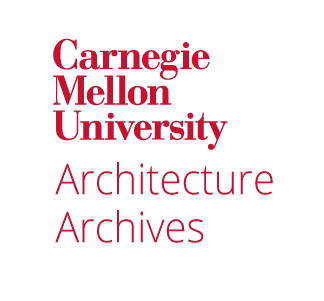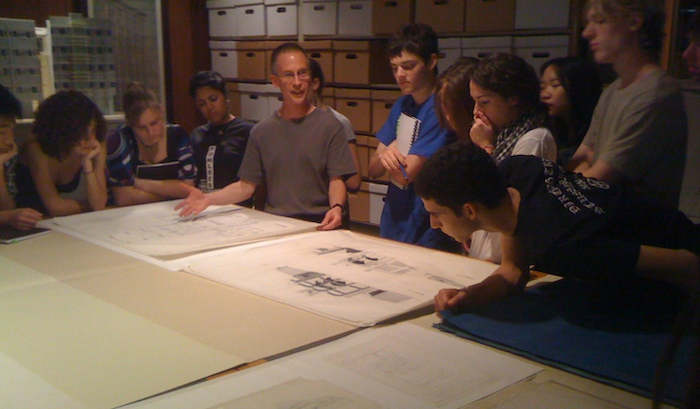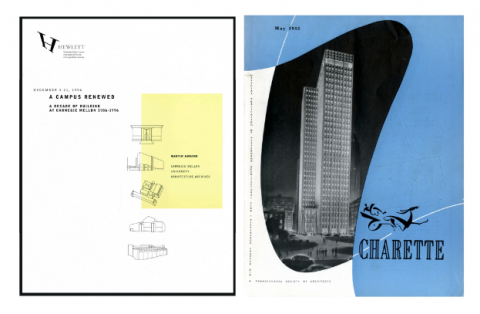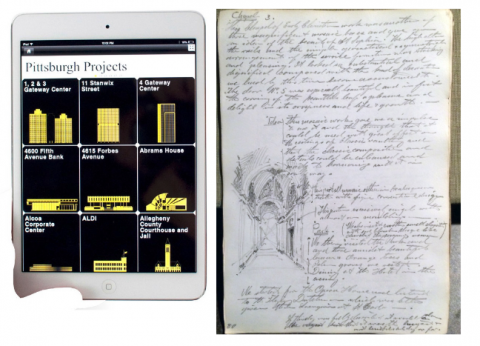

I first came to Carnegie Mellon as a researcher. The Frederick G., Scheibler, Jr. Collection in the Carnegie Mellon University Architecture Archives made my research project possible. I now know that the Architecture Archives is an important resource for other researchers working on articles, books, and exhibitions; that faculty and students in the School of Architecture consult the Architecture Archives' collections for research and inspiration; and that architects and property owners turn to the Architecture Archives for drawings for restoration or renovation projects. My research visits turned into a career. I am retiring from Carnegie Mellon after more than thirty years as Architecture Librarian and Archivist. This seems like a good time to review key episodes in the history of the Architecture Archives.
Origins
Fine Arts Librarian Henry Pisciotta and Professor Richard Cleary founded the Carnegie Mellon University Architecture Archives in 1984 as a collaborative project of Carnegie Mellon's University Libraries and School of Architecture (the University Libraries subsequently assumed sole responsibility). The Architecture Archives was initially organized around three collections already held by the university: the Henry Hornbostel, Frederick G. Scheibler, Jr., and Peter Berndtson Collections, though many additional collections have been added since that time. Pisciotta and Cleary curated an inaugural 1985 exhibition, "Three Pittsburgh Architects: Selections from the Carnegie Mellon University Architecture Archives." Early fund-raising efforts yielded two endowment funds—the William Arthur Thomas Memorial Fund and the Lucian Caste Fund—that fund the work of the Architecture Archives. The Pittsburgh History & Landmarks Foundation rewarded these early efforts with an Award of Merit in 1989.
A Campus Renewed
In 1987, Carnegie Mellon selected architectural firms to compete in the University Center Competition, a competition for the design of a University Center and the conceptualization of various other buildings for the Pittsburgh campus. Thereafter, the university undertook a major building program that substantially reshaped and renewed the campus, contributed significant new architecture to Pittsburgh, and was among the most ambitious such efforts by an American university during this period. The Architecture Archives responded with "A Campus Renewed: A Decade of Building at Carnegie Mellon 1986-1996." The Architecture Archives acquired pertinent collections, and in conjunction with the College of Fine Arts' Hewlett Gallery, presented an exhibition, published an exhibition catalog, and hosted a provocative public lecture by Peter Bohlin of Bohlin Cywinski Jackson, and Michael Dennis of Michael Dennis & Associates, the key protagonists of the new campus architecture.

Charette Digital Project
In the early 2000s, the Architecture Archives and the University Libraries' department of Archives and Digital Library Initiatives digitized "Charette" (vols. 1-54, 1920-1974), the journal of the Pittsburgh Architectural Club (in some years co-sponsored by the Pittsburgh Chapter of the American Institute of Architects and the Pennsylvania Society of Architects). "Charette" featured criticism and commentary on architecture as well as copious information about buildings and the activities of the sponsoring architectural organizations. Over time, it provided a rich survey of the historical and contemporary architecture of Pittsburgh and Pennsylvania. The Charette Digital Project created a digital archive of the journal. Electronic images of each page include text, photographs, graphics, and advertisements. The resulting database permits electronic access to "Charette" with browsing by issue and full-text searching of the journal's contents. This is an essential resource for architectural research in the region.
Pittsburgh Projects | Imagining the Modern
From 2014-2019 a multi-faceted collaborative project engaged the Architecture Archives at every turn and leveraged the Architecture Archives' rich collections that document Pittsburgh's post-World War II Renaissance era. I joined with Kelly Hutzell and Rami el Samahy, two professors in the Carnegie Mellon's School of Architecture, to conceive and build a mobile architectural guidebook application that was initially called Pittsburgh Projects. It won awards from the American Institute of Architects but it is unfortunately no longer available for download. The application was featured in "HAC Lab Pittsburgh: Imagining the Modern," a groundbreaking exhibition at the Heinz Architectural Center of the Carnegie Museum of Art, which addressed Pittsburgh's complicated relationship with modern architecture and urban planning. The exhibit, curated by the design firm over,under, included an abundance of archival materials borrowed from the Architecture Archives. This exhibit was later adapted into a book, "Imagining the Modern: Architecture and Urbanism of the Pittsburgh Renaissance," which was published by Monacelli Press with support from the Architecture Archives.
Hornbostel in Europe
Finally, I want to call out Professor Francesca Torello's ongoing project, "An Architects' Travels: Hornbostel in Europe," which addresses Henry Hornbostel's 1893 travel journal that is preserved in the Architecture Archives. The journal, which is accompanied by a small sketchbook, describes the extensive European trip that Hornbostel took before beginning his studies at the École des Beaux Arts in Paris. These extraordinary documents contain wonderful sketches, annotations on architectural materials and design solutions, as well as Hornbostel's written opinions about buildings and sites. Torello is transcribing and interpreting these documents to make them available to the public in collaboration with members of the Libraries' division of Innovation, Preservation, and Access. Torello is also developing scholarly work to connect the documents to other travel narratives, to the history of the education of architects, to the concept of didactic architecture, and more specifically—with Professor Joshua Bard—to the College of Fine Arts building at Carnegie Mellon, a building for the arts designed as a travel surrogate and an immersive didactic experience.
Martin Aurand, Principal Librarian/Archivist

